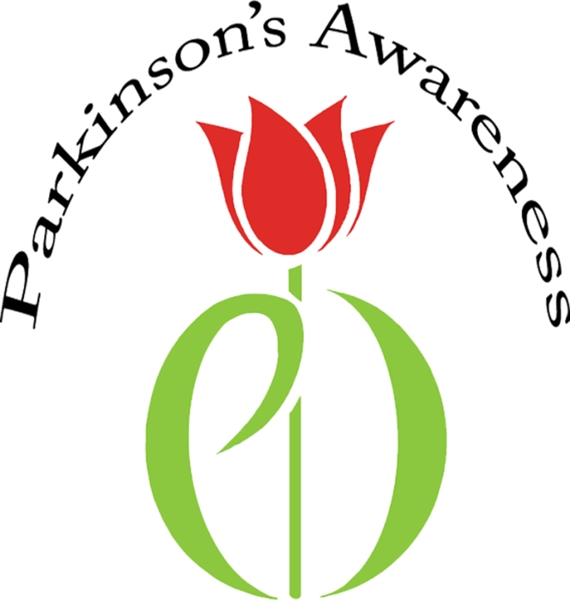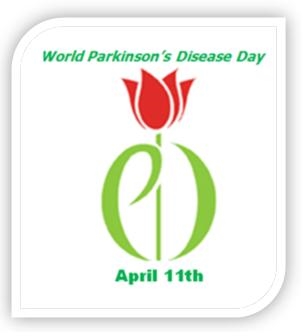World Parkinson's Disease Day 2024 is on Thursday, April 11, 2024: Parkinson's Question?
Thursday, April 11, 2024 is World Parkinson's Disease Day 2024. Parkinson's Symptoms Start here to learn more about the symptoms of Parkinson's disease.
As an Amazon Associate I earn from qualifying purchases.

You already know that Parkinson's is a chronic, incurable progressive neurodegenerative disease causing both motor and non-motor symptoms. Rather than being one definable condition with everyone moving from stage to stage with the same symptoms within a similar time frame, PD is actually a collection of syndromes.
The most common symptoms are TRAP: Tremors, Rigidity, Akinesia (Bradykinesia/slowness of movement) and Postural Instability. There is a long list of symptoms but that is not the issue here.
Your friend does not appear to have all of those symptoms. Although she may not have postural instability and you do not mention tremors (common to about 75% of PwPs) she certainly has rigidity. She may also not be that slow in movement or reaction time. However, there is a form of PD in which the prominent symptom at onset is stiffness.
We know that your friend has a serious problem with stiffness, range of motion and freezing motion. She may still have fairly normal reaction time which allows her to continue to drive because she is not suffering from slowed reactions or vision problems, another symptom.
She has trouble dressing because of the symptoms above and she freezes in doorways which is very common to many PwPs. Eventually this freezing may extend to normal walking or any narrow space. At this point she risks falling which is basically the 2nd leading cause of death in Parkinson's patients.
The thing about Parkinson's disease is that the most common PD medication which helps relieve many symptoms can also cause some horrible side effects as the years go on. Your friend obviously has a "wearing off" time (as do all PwPs on levodopa/carbidopa) and is reluctant to increase her doses because the dystonias which eventually occur can make things quite a bit more "un-normal" for her.
There are a few other medications which she could be taking but it doesn't sound as if she is. Those too have side effects - some of them can be enough to make her stop taking them.
I think you friend might be adjusting her dosing times in order to get the most out of a particular period of time. My guess is that she may splurge and take an extra dose to drive long distances or party with her friends. She cannot do this in a regular basis or the "wearing off" times will eventually come closer and closer together.
Her next step at this point would be surgery - if she is a surgical candidate. The problem with DBS surgery is that deep brain stimulation can sometimes cause additional problems with speech and cognition.
One of the best exercises for Parkinson's disease is Forced Exercise usually done on a specialized stationary bike. As a matter of fact, done properly, this therapy can actually reduce symptoms and reliance on meds for a few weeks.
Although I don't think your friend is doing the 90 rpm cycling for 40 minutes, she may actually be benefiting from a sustained period of this repetitive exercise. Or she is going to a great center with the right stuff.
(To tell you the truth, I would love to hear more about her routine because what you have related is very significant to the PD world)
One therapy used by people with Parkinson's is dancing - preferably the Tango because of the rhythm. People arrive at these sessions with canes, walkers and wheelchairs. The hobble to the dance floor and then dance with ease once the music starts. The brain is both a remarkable and devastating thing.
Another important consideration is stress. Stress can often make certain symptoms such as tremor much worse. The stress of working and worrying about job performance or being challenged by her supervisors at work may be over the top for her. I think you friend is looking down the road and worrying that she may not be able to hold off progression much longer.
Not knowing her age, the length of time she has had PD or the medications, supplements she is taking it is difficult to be more specific.
There is another way to view this. Think of all the difficult times she has, there may be more things than you know about. She might not be mentioning the swallowing problems or the urinary issues nor the sleep problem or a loss of sense of smell or any number of things that she doesn't want to make public. PwPs rarely talk about the pain except to each other.
When she needs help getting dressed or freezes in a doorway or needs help walking into the exercise center, that is her Parkinson's disease. When she seems most normal, that is the medication.
Does massage therapy help Parkinson's patients?
Massages helps you to relax, Now a days there are lots of Massages in a world. Some are cheap and some are very costly. Some of the massages help you to skin care, waxing etc. For more details visit following link.

In the world as a whole what is the number one way to die?
Well, aren't you just a little ray of sunshine on a rainy day? Seriously - are you being held in this country against your will? Because my friends and I will come and spring you, and ship you to whatever place you would prefer to live.
to answer your actual question though, here is a list of worldwide mortality causes, listed in order.
[1] Cause Percent
of
deaths Deaths per 100,000 per year
All Male Female
– All Causes 100.00 916.1 954.7 877.1
A Cardiovascular diseases 29.34 268.8 259.3 278.4
B Infectious and parasitic diseases 19.12 175.2 185.1 165.1
A.1 Ischemic heart disease 12.64 115.8 121.4 110.1
C Malignant neoplasms (cancers) 12.49 114.4 126.9 101.7
A.2 Cerebrovascular disease (Stroke) 9.66 88.5 81.4 95.6
B.1 Respiratory infections 6.95 63.7 63.5 63.8
B.1.1 Lower respiratory tract infections 6.81 62.4 62.2 62.6
D Respiratory diseases 6.49 59.5 61.1 57.9
E Unintentional injuries 6.23 57.0 73.7 40.2
B.2 HIV/AIDS 4.87 44.6 46.2 43.0
D.1 Chronic obstructive pulmonary disease 4.82 44.1 45.1 43.1
– Perinatal conditions 4.32 39.6 43.7 35.4
F Digestive diseases 3.45 31.6 34.9 28.2
B.3 Diarrheal diseases 3.15 28.9 30.0 27.8
G Intentional injuries (suicide, murder, war, etc.) 2.84 26.0 37.0 14.9
B.4 Tuberculosis 2.75 25.2 32.9 17.3
B.5 Malaria 2.23 20.4 19.4 21.5
C.1 Lung cancers 2.18 20.0 28.4 11.4
E.1 Road traffic accidents 2.09 19.1 27.8 10.4
B.6 Childhood diseases 1.97 18.1 18.0 18.2
H Neuropsychiatric disorders 1.95 17.9 18.4 17.3
– Diabetes mellitus 1.73 15.9 14.1 17.7
A.3 Hypertensive heart disease 1.60 14.6 13.4 15.9
G.1 Suicide 1.53 14.0 17.4 10.6
C.2 Stomach cancer 1.49 13.7 16.7 10.5
I Diseases of the genitourinary system 1.49 13.6 14.1 13.1
F.1 Cirrhosis of the liver 1.38 12.6 16.1 9.1
I.1 Nephritis/nephropathy 1.19 10.9 11.0 10.7
C.3 Colorectal cancer 1.09 10.0 10.3 9.7
C.4 Liver cancer 1.08 9.9 13.6 6.2
B.6.1 Measles 1.07 9.8 9.8 9.9
G.2 Violence 0.98 9.0 14.2 3.7
– Maternal conditions 0.89 8.2 0.0 16.5
– Congenital abnormalities 0.86 7.9 8.1 7.7
J Nutritional deficiencies 0.85 7.8 6.9 8.7
C.5 Breast cancer 0.84 7.7 0.1 15.3
C.6 Esophageal cancer 0.78 7.2 9.1 5.2
A.4 Inflammatory heart disease 0.71 6.5 6.7 6.2
H.1 Alzheimer's disease and other dementias 0.70 6.4 4.7 8.1
E.2 Falls 0.69 6.3 7.5 5.0
E.3 Drowning 0.67 6.1 8.4 3.9
E.4 Poisoning 0.61 5.6 7.2 4.0
C.7 Lymphomas, multiple myeloma 0.59 5.4 5.4 5.4
A.5 Rheumatic heart disease 0.57 5.3 4.4 6.1
C.8 Oral cancers and oropharynx cancers 0.56 5.1 7.1 3.1
E.5 Fires 0.55 5.0 3.8 6.2
B.6.2 Pertussis 0.52 4.7 4.7 4.8
C.9 Prostate cancer 0.47 4.3 8.6 0.0
C.10 Leukemia 0.46 4.2 4.7 3.8
F.2 Peptic ulcer disease 0.46 4.2 5.0 3.5
J.1 Protein-energy malnutrition 0.46 4.2 4.2 4.2
– Endocrine/nutritional disorders 0.43 3.9 3.4 4.4
D.2 Asthma 0.42 3.9 3.9 3.8
C.11 Cervical cancer 0.42 3.8 0.0 7.7
C.12 Pancreatic cancer 0.41 3.7 3.9 3.5
B.6.3 Tetanus 0.38 3.4 3.4 3.5
B.7 Sexually transmitted diseases excluding HIV 0.32 2.9 2.9 2.9
C.13 Bladder cancer 0.31 2.9 4.0 1.7
B.8 Meningitis 0.30 2.8 2.9 2.7
G.3 War 0.30 2.8 5.0 0.5
B.7.1 Syphilis 0.28 2.5 2.7 2.3
– Neoplasms other than malignant 0.26 2.4 2.4 2.4
J.2 Iron deficiency anemia 0.24 2.2 1.5 2.9
C.14 Ovarian cancer 0.24 2.2 0.0 4.4
B.9 Tropical diseases 0.23 2.1 2.5 1.6
H.2 Epilepsy 0.22 2.0 2.2 1.8
– Musculoskeletal diseases 0.19 1.7 1.2 2.2
B.10 Hepatitis B 0.18 1.7 2.3 1.0
H.3 Parkinson's disease 0.17 1.6 1.6 1.6
H.4 Alcohol use disorders 0.16 1.5 2.5 0.4
H.5 Drug use disorders 0.15 1.4 2.2 0.5
B.1.2 Upper respiratory infections 0.13 1.2 1.2 1.2
C.15 Uterine cancer 0.12 1.1 0.0 2.3
– Skin diseases 0.12 1.1 0.8 1.4
C.16 Melanoma and other skin cancers 0.12 1.1 1.1 1.0
B.11 Hepatitis C 0.09 0.9 1.1 0.6
B.9.1 Leishmaniasis 0.09 0.8 1.0 0.7
B.9.2 Trypanosomiasis 0.08 0.8 1.0 0.5
I.2 Benign prostatic hyperplasia
















